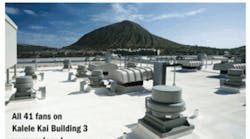At Kalele Kai, a residential community in Oahu's Hawaii Kai, aging centrifugal roof exhaust fans provided no adjustability and were consuming a lot of energy. Hoping to find a more energy-efficient solution, one that would help the condominiums qualify for rebates offered by the local electric company, Alex Dean, president of The Alexander Group Inc. and energy consultant for Kalele Kai's board of directors, approached HVAC manufacturers’ representative Norman S. Wright Co. in June 2008.
Two months later, Greenheck provided three Model G test fans with Vari-Green motors and sent a team to install the fans for energy- and air-performance comparison. The remainder of the fans (models G-101-VG and G-121-VG with ¼-hp Vari-Green motors and Model G-131-VG with ½-hp Vari-Green motors) were installed in early 2009.
The Solution
The main challenge was providing fans that could meet the strict energy-savings requirements of the local electric company's demand-side-energy rebate program. The Model G centrifugal roof exhaust fans with Vari-Green motors provided the required energy savings. The low-maintenance, direct-drive Vari-Green motor can operate at 80-percent turndown of full speed, compared with 30-percent turndown for industry-standard permanent-split-capacitor (PSC) motors.
A built-in speed controller allows the fans to be adjusted to specific airflow requirements quickly and easily, reducing cooling costs. The energy efficiency of Vari-Green motors is 20- to 60-percent higher than that of PSC motors, providing additional energy savings.
Each fan came with a specially designed adaptor to fit the existing building curb so Kalele Kai's maintenance crew could install the new fans easily.
Results
Dean performed an energy study, determining that the new fans have reduced energy consumption from 129,000 kwh per year to 39,000 kwh per year. At Hawaii's energy rate of 19 cents per kilowatt-hour, the savings are $17,100 per year, a figure confirmed by the local electric company.
On top of the energy savings, exhaust rates have been adjusted to the appropriate levels, which has reduced the amount of conditioned air being exhausted. As a bonus, the fans run cooler and quieter, decreasing noise and increasing motor life.
According to Dean, the board of directors is planning to upgrade the ventilation systems on two other buildings in the near future.









